Source: Glassnode; Compiled by: Baishui, Golden Finance
Summary
Capital flows into Bitcoin remain positive, although the size of inflows has declined since the first $100,000 level. This highlights a period when sell-side pressure is declining as the market approaches short-term equilibrium.
Sell-side pressure from long-term investors has also declined, along with a decline in the amount of deposits on exchanges for sale.
Several volatility indicators are tightening, with the market trading within a historically narrow 60-day price range, which generally indicates that the market is almost ready to move again.
Capital Flows Approaching Balance
Net capital inflows into Bitcoin surged as prices reached the $100,000 level, indicating that investors are locking in significant profits. These capital inflows have begun to decline as the market consolidates and adjusts to the new price range.
The slowdown in profit taking represents a net reduction in seller power, so less new capital is needed to maintain prices within a trading range.
Currently, realized market capitalization is trading at $832 billion and growing at a rate of $38.6 billion per month.
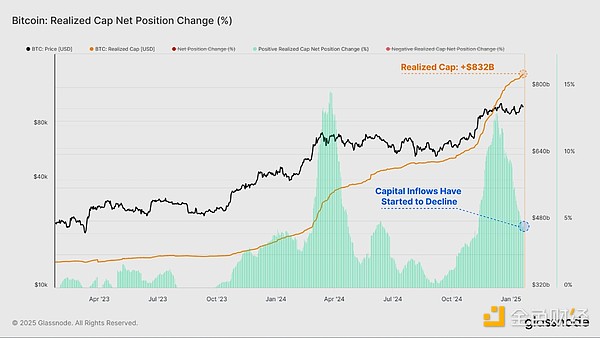
The net realized profit/loss metric is the first derivative of realized market capitalization and allows us to discretely observe the size of on-chain net capital flows denominated in USD.
The balance of realized profit and loss volumes is moving toward a neutral position as the market digests profit-taking allocation pressures. This suggests that supply and demand forces are resetting and that most tokens currently trading do not have a large incremental value locked in relative to the initial acquisition price.
Profit-taking volume peaked at +4.5 billion USD in December 2024 and has now fallen to +316.7 million USD (-93%).
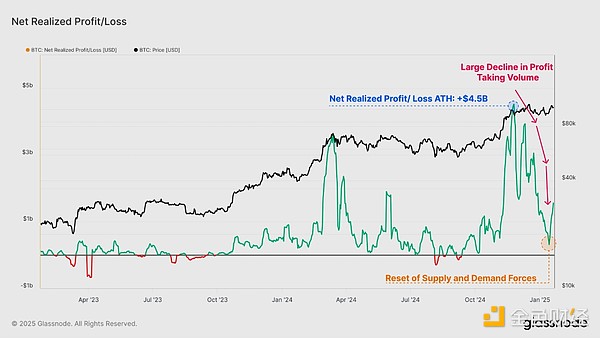
The absolute volume of realized profits and realized losses (entity-adjusted) is another set of tools that help us gauge the direction and sentiment of capital flowing into and out of Bitcoin.
When we add realized profits and losses together, we can see that this composite metric has fallen dramatically from a high of $4 billion to a value of $1.4 billion. Despite a 65% drop, current values are still high from a historical perspective, highlighting the scale of daily demand to absorb this capital during the bull market.
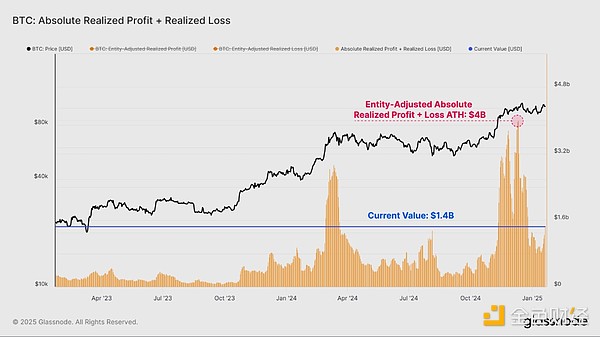
Supply-Side Slowdown
We have already established that overall sell-side pressure has clearly declined. We can further investigate these dynamics using indicators such as Coinday Destruction and exchange inflows to confirm this view.
The first tool we can use to better describe investor allocation pressure is the Binary CDD indicator. This indicator tracks "hold time" expenditure across the market, tracking when old supply holders are trading increasing amounts.
We saw a sustained period of severe coinday destruction in late 2024 and early January. This indicator has begun to cool in recent weeks as relatively mild coinday destruction has taken over.
This suggests that a large number of investors who were planning to take profits may have taken profits within the current price range. Generally speaking, this suggests that the market may need to "look elsewhere" to attract and unlock the next wave of supply.
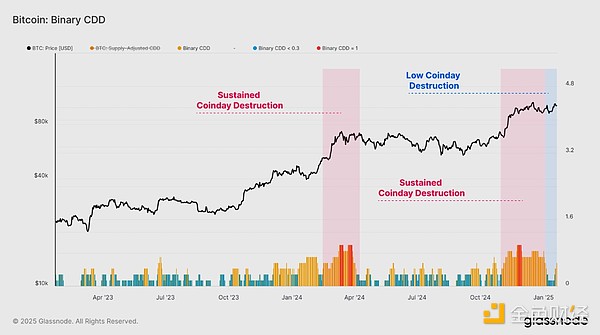
The Long Term Holders (LTH) binary spending indicator is another indicator we can use to assess the duration of sustained seller pressure. This tool specifically targets long-term investors.
Consistent with the previous large amount of profit taking volume, we can see that the total LTH supply fell sharply as the market reached $100,000 in December. The rate at which LTH supply has fallen has since stalled, indicating that this distribution pressure has eased in recent weeks.
Currently, the total LTH supply is starting to show signs of recovery, indicating that for this group, accumulation and HODLing behavior is now greater than distribution pressure.
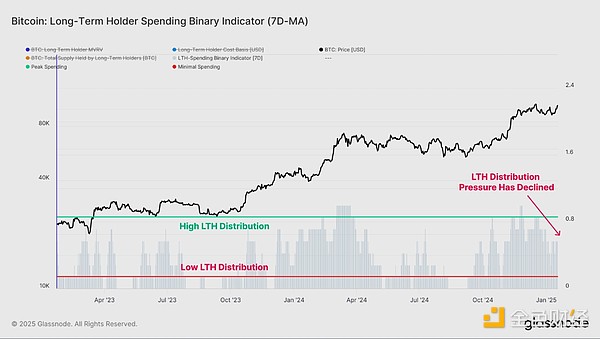
Centralized exchanges remain the main venue for speculation and trading, processing billions of dollars in capital flows every day. Exchange inflows have fallen sharply from a peak of $6.1 billion to $2.8 billion (-54%), highlighting the sharp decline in recent speculative activity.
Notably, LTH inflows to exchanges have fallen from $526.9 million in December to $92.3 million currently, with deposits falling by -83%.
This further supports the argument that long-term investors may have completed a large amount of profit-taking in this price range.
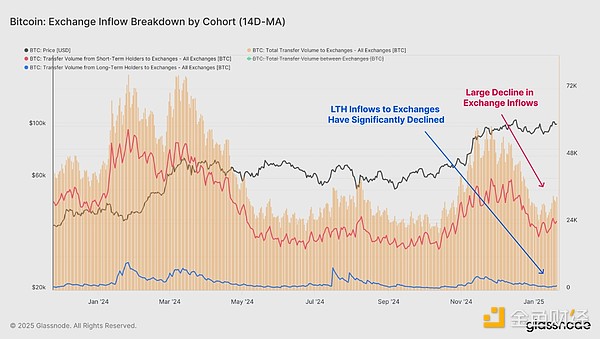
To further analyze the supply and demand balance, we can compare the rate of change of balances of different groups and normalize them to the amount of BTC mined. This provides a relative measure compared to the amount of new issuance each group theoretically absorbed.
Taking the Shrimp and Crab group (holding <10 BTC) as a representative of retail and individual investors, we notice that this group absorbed about +25.6k BTC in the past month. By comparison, miners issue ~+13.6k BTC per month.
Thus, these retail and individual holders are effectively absorbing 1.9x the new supply that enters the market via primary production.
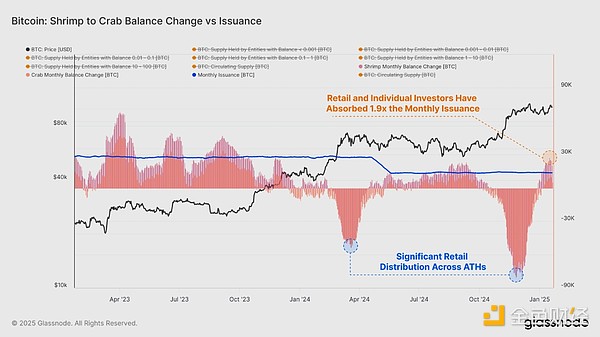
Coiling Volatility
As can be seen, there is a strong convergence between the two on-chain models and the historically narrow 60-day price ranges, allowing investors to preempt increased volatility.
By measuring the percentage range between the highest and lowest prices over the past 60 days, we can see how market volatility has changed over time. The chart below highlights periods where the 60-day price range was narrower than the current trading range. All of these situations occurred before a major burst of volatility, most of which occurred in the early stages of a bull market, or before a sell-off in the late stages of a bear market cycle.
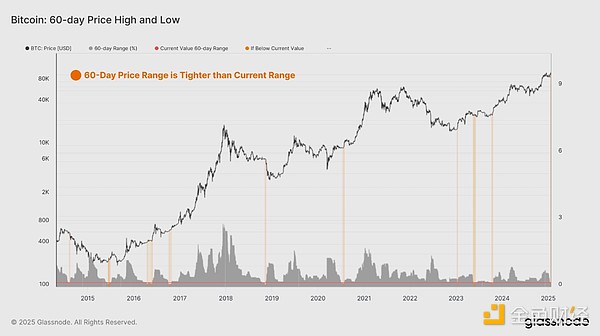
Continued sideways price action within a narrow range allows a large portion of the circulating supply to be reallocated and concentrated around a relatively high cost basis.
The actual supply density metric quantifies the concentration of supply within a ±15% price change range of the current spot price. When supply is highly concentrated around the spot price, small price fluctuations can significantly affect investor profitability, which in turn exacerbates market volatility.
After the Bitcoin price peaked in December, it began to consolidate, forming a dense supply concentration with a cost basis close to the spot price. Currently, 20% of the supply is within ±15% of the spot price.
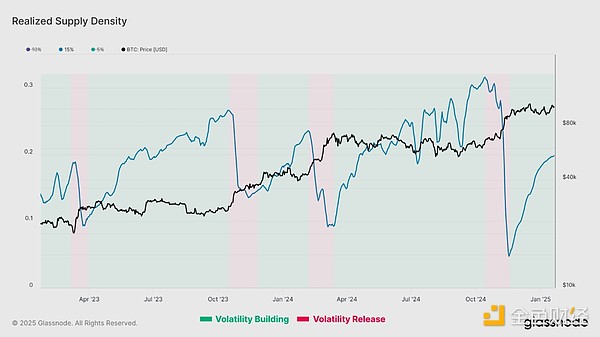
The sell-side risk ratio describes this phenomenon from a different perspective. This metric assesses the total realized profits and losses locked in by investors relative to the size of the asset (measured by realized market capitalization). We can think of this metric in the following framework:
High values indicate that investors are making large profits or losses relative to their cost basis when spending tokens. This situation indicates that the market may need to rebalance and usually occurs after high volatility price movements.
The low value indicates that most tokens are being spent relatively close to their breakeven cost basis, indicating that a degree of equilibrium has been reached. This situation typically indicates that the "profit and loss" within the current price range has been exhausted, and generally describes a low volatility environment.
Short-term holder spending activity has contracted significantly in recent weeks, causing sell-side risk to drop sharply. This typically means that all profit and loss events planned by investors have now been executed. It tends to indicate that the market is close to a local equilibrium and is a precursor to the next wave of volatility.
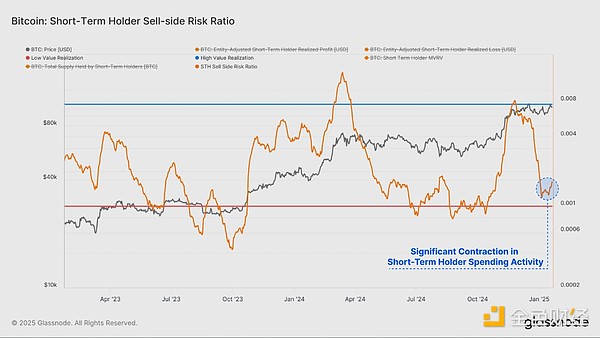
Summary
Bitcoin prices experienced dramatic intraday volatility, surging to a new high of $109,000 before plunging and then stabilizing above $100,000. The macro backdrop leading up to and during the U.S. presidential inauguration was challenging and uncertain, exacerbating the level of market indecision.
In this article, we assess and analyze the conditions that preceded the explosive but shaky price move. We propose a framework that uses reductions in on-chain volume and capital flows, as well as tightening price ranges, to identify signs of impending volatility.
 YouQuan
YouQuan













